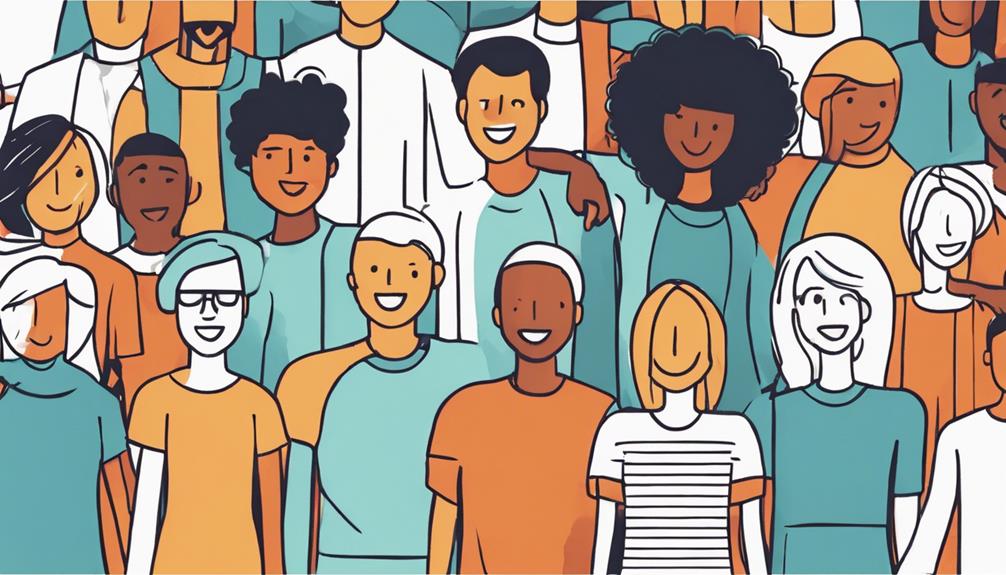In the realm of societal psychology, the significance of community stands as a cornerstone in the intricate web of human interactions. The fabric of community intertwines personal well-being with social interconnectedness, generating a profound impact on the collective psyche. As we navigate the labyrinth of human existence, the role of community emerges as a critical factor in shaping our identities and fostering resilience in the face of adversity. It is within the communal embrace that individuals find solace, purpose, and a shared sense of purpose. The question remains: in a world increasingly defined by individualistic pursuits, how do we preserve and enhance the essence of community for future generations?
Key Takeaways
- Community support enhances mental and physical well-being through reducing isolation and providing coping mechanisms.
- Identity formation and belonging in a community positively impact self-perception and mental health.
- Community engagement fosters strong relationships, reducing feelings of isolation and promoting positive mental states.
- Employee Resource Groups (ERGs) promote diversity, inclusivity, and collaboration, enhancing creativity and professional development.
The Power of Belonging

Belonging to a community holds significant influence on individuals' mental and physical well-being, offering a foundation of support and connection crucial for navigating life's challenges. Within a community, individuals find a support network that plays a vital role in promoting overall health. This support network helps in reducing feelings of isolation and loneliness, which have been associated with various negative health outcomes. Furthermore, being part of a community provides a sense of identity, as shared values, beliefs, and relationships contribute to shaping an individual's self-perception.
The sense of identity derived from community membership fosters a feeling of belonging and purpose. This, in turn, enhances psychological well-being and resilience, enabling individuals to better cope with stress and adversity. The support system within a community not only offers emotional support but also practical assistance during difficult times. As individuals engage with their community, they develop relationships that provide a sense of security and belonging, ultimately leading to improved mental and physical health outcomes.
Support Systems in Community
Communities serve as crucial pillars for individuals by offering a web of support systems that cater to various needs. Through community support networks, individuals can access emotional reassurance, practical assistance, and valuable guidance during challenging circumstances. Building strong relationships within a community not only fosters a sense of belonging but also plays a pivotal role in enhancing overall well-being.
Community Support Networks
Within the fabric of society, community support networks serve as essential pillars that offer individuals a foundation of emotional, practical, and advisory assistance during times of adversity. These networks play a crucial role in promoting mental health by providing a sense of belonging, identity, and shared values to community members. Engaging with community support systems has been shown to reduce feelings of stress and isolation, contributing to positive mental well-being outcomes. Moreover, being part of a community support network not only enhances mental health but also positively impacts physical health by lowering risks such as high blood pressure and obesity. Overall, community support networks are vital for improving the quality of life and well-being of individuals within a community.
Building Strong Relationships
Fostering strong relationships within a community is essential for establishing robust support systems that provide individuals with emotional assistance, practical guidance, and a sense of camaraderie during challenging circumstances. By building connections in a community, individuals create a safety net of emotional support, enhancing their mental well-being and reducing feelings of isolation. Support systems within communities offer not only advice and empathy but also a shared sense of identity and values, strengthening social bonds. This sense of belonging and support contributes to individual resilience, improved coping mechanisms, and an overall higher quality of life. The table below summarizes the key aspects of building strong relationships in a community:
| Community Building | Emotional Support |
|---|---|
| Establishing robust support systems | Providing emotional assistance |
| Fostering a sense of identity and shared values | Reducing feelings of isolation |
| Enhancing mental well-being | Strengthening social bonds |
| Improving individual resilience and coping mechanisms | Contributing to a higher quality of life |
Identity Formation Within Communities

Membership in specific social groups significantly influences individuals' identity formation processes, shaping their self-perception and worldview. Within communities, shared values and a sense of belonging play a fundamental role in shaping one's identity. The stories and narratives passed down within these social groups contribute to the development of a collective identity that members can relate to. By identifying with these shared stories, individuals internalize the values and beliefs of the community, which in turn influence their own personal values and beliefs.
Belonging to a community provides individuals with a framework through which they can understand themselves and their place in the world. This shared identity fosters a sense of connection and solidarity among members, reinforcing their self-perception. Furthermore, communities offer a supportive environment where individuals can explore and express their identities without fear of judgment.
In essence, identity formation within communities is a dynamic process that is deeply intertwined with the shared values and sense of belonging that these social groups provide.
Stress Reduction Through Community
Belonging to a community not only fosters a sense of connection and solidarity but also has scientifically proven benefits in reducing stress levels and promoting overall well-being. Studies have shown that individuals who are actively engaged in a community experience lower levels of stress, leading to improved mental health. The social support and camaraderie found within a community setting play a crucial role in stress reduction. Being part of a community provides a sense of belonging and purpose, which can alleviate feelings of isolation and anxiety, thus contributing to enhanced mental well-being.
Furthermore, the interactions and relationships formed within a community offer avenues for sharing experiences, seeking advice, and receiving emotional support. These factors are instrumental in combating stress and fostering a positive mental state. Engaging with others in a community can lead to increased self-esteem, reduced feelings of loneliness, and a greater sense of fulfillment. Ultimately, the collective efforts and connections within a community serve as protective factors against stress and contribute significantly to overall mental health.
Combating Isolation Through Community

Community serves as a crucial element in combating isolation by providing individuals with social support networks. The sense of belonging that comes with being part of a community can greatly contribute to emotional well-being. Understanding the impact of community on combating isolation is essential for promoting overall health and wellness.
Social Support Networks
Social connections within supportive networks play a crucial role in countering feelings of isolation and promoting overall well-being. Engaging with social support networks can provide emotional support, practical help, and advice during challenging times. These connections help reduce stress and loneliness, leading to improved physical health outcomes such as lower blood pressure, cholesterol levels, and obesity risk. Community involvement also enhances mental well-being by fostering a sense of belonging and support. Joining clubs, organizations, or support groups can help individuals feel less alone and more connected to a larger entity, ultimately enhancing their overall well-being.
| Benefits of Social Support Networks |
|---|
| Emotional support during tough times |
| Lower stress and loneliness levels |
| Improved physical health outcomes |
| Enhanced mental well-being |
Sense of Belonging
A fundamental human need recognized across various disciplines, the establishment of strong interpersonal connections within a collective environment is pivotal in mitigating the adverse effects of isolation and fostering psychological well-being. A sense of belonging plays a crucial role in combating feelings of isolation, offering individuals a supportive network that contributes to their overall health. Here are key points illustrating the significance of a sense of belonging within a community:
- Reduction of Isolation: Being part of a community diminishes feelings of loneliness and isolation.
- Enhanced Mental Health: Membership in a community can alleviate stress and improve mental well-being.
- Positive Physical Outcomes: Connection to a community may result in improved physical health indicators like lower blood pressure and cholesterol levels.
- Support System: Community involvement provides a support system during challenging times, enhancing overall well-being.
Emotional Well-Being
The foundation of emotional well-being lies in the profound impact of interpersonal connections within a collective environment, particularly in addressing the challenges of isolation and fostering psychological resilience. Community helps combat feelings of loneliness and promotes a sense of belonging, which are crucial for maintaining emotional health. Studies show that connecting with a community can reduce stress, lower blood pressure, and decrease the risk of chronic diseases. Additionally, active participation in a community increases the likelihood of engaging in regular exercise and maintaining a healthy diet, further contributing to emotional well-being. Feeling part of a larger entity through community connection not only improves mental health by reducing anxiety and depression but also has physical health benefits such as reduced stress levels. Engaging with a community is a powerful tool in nurturing emotional well-being.
Various Forms of Community Engagement

Engagement with various forms of community can significantly enhance social connections and well-being. When individuals participate in different community activities, they not only contribute to the collective good but also experience personal benefits. The following list outlines some key forms of community engagement:
- Joining Clubs and Organizations: Being part of a group of individuals with shared interests fosters a sense of belonging and support, promoting overall well-being.
- Involvement in Support Groups: Participating in support groups provides individuals with a space to connect with others facing similar challenges, leading to a sense of community and understanding.
- Volunteering in the Community: Volunteering not only benefits the community but also has positive effects on physical health, such as lowering blood pressure and reducing stress levels.
- Attending Community Events: Engaging in community events offers opportunities to build relationships with neighbors, enhancing social connections and support systems.
Community Impact on Mental Health
The impact of community on mental health is substantial, with benefits including enhanced self-esteem and mental well-being, strengthened social support networks, and a heightened sense of belonging. Individuals engaging in positive activities within their community often experience a boost in self-worth and a decrease in feelings of isolation. Moreover, the acceptance and understanding offered within a community setting can contribute significantly to an individual's overall mental health and sense of fulfillment.
Mental Health Benefits
Within communities, individuals experience a profound impact on their mental health through increased self-esteem and empowerment derived from shared learning and engagement in positive activities. Community involvement offers a platform for individuals to enhance their mental wellness through diverse interactions and shared experiences. The following aspects highlight the mental health benefits of being part of a community:
- Boosting Self-Esteem: Active participation in community activities fosters a sense of accomplishment and boosts self-worth.
- Promoting Mental Wellness: Engagement in positive activities and learning from various community members contribute to enhanced mental well-being.
- Facilitating Acceptance: Communities provide a space for practicing acceptance and self-acceptance, promoting mental health.
- Reducing Isolation: Feeling connected to a community diminishes feelings of isolation, fostering better mental health outcomes.
Social Support Networks
Social support networks within communities play a crucial role in influencing mental health outcomes by providing individuals with a strong sense of belonging and resources to cope with stressors. Research has shown that these networks can reduce feelings of loneliness and isolation, which are risk factors for mental health issues. By fostering supportive relationships, communities can enhance self-esteem and contribute to positive mental well-being. Moreover, the resources, advice, and emotional support offered within communities help individuals navigate through stress and mental health challenges effectively. Engaging with diverse community members also exposes individuals to valuable perspectives and insights that promote mental wellness. Thus, the presence of social support networks in communities is vital for maintaining and improving mental health.
Sense of Belonging
Influencing mental health outcomes significantly, a strong sense of belonging within a community reduces feelings of loneliness and isolation, factors closely associated with increased risks of mental health issues.
Key Points:
- Reduced Loneliness and Isolation: Sense of belonging in a community decreases feelings of loneliness, which can contribute to mental health challenges.
- Support System: Being part of a community provides a support network that fosters positive mental health outcomes.
- Enhanced Well-being: Community connection boosts self-esteem, purpose, and overall mental well-being.
- Stress and Anxiety Reduction: Individuals with a strong sense of belonging experience lower levels of stress and anxiety, promoting better mental health.
Feeling connected to a community offers acceptance, validation, and emotional support, essential elements for maintaining good mental health.
Benefits of Community Involvement
Participation in community activities has been proven to significantly enhance psychological well-being and physical health through the provision of support, belonging, and opportunities for social engagement. The sense of support within a community can act as a buffer against stress, reducing the risk of isolation and its negative impact on mental health. Additionally, the social connections formed through community involvement can lead to improved physical health outcomes. Studies have shown that individuals who engage with their community are more likely to have lower blood pressure, healthier cholesterol levels, and a reduced risk of obesity. Furthermore, being part of a community often encourages healthier lifestyle choices, such as regular exercise and a balanced diet. By building relationships with neighbors and actively participating in community events, individuals can experience a boost in their mental well-being, highlighting the interconnectedness of community involvement with both psychological and physical health benefits.
Building Strong Connections

Establishing robust connections within a community plays a pivotal role in fostering a sense of belonging and support among individuals. Strong social connections are crucial for enhancing the quality of life and overall well-being of community members. This is achieved through various means, such as:
- Increased Happiness: Strong social connections in a community lead to increased happiness levels as individuals feel connected, valued, and understood by others.
- Sharing Experiences and Ideas: Communities provide a platform for individuals to share experiences, ideas, and emotions, creating a sense of unity and mutual understanding.
- Reduced Feelings of Isolation: Connection within a community reduces feelings of isolation and loneliness, promoting mental health and emotional well-being.
- Lifelong Friendships and Support: Engaging with a community can lead to the development of lifelong friendships and a robust support system during challenging times, ensuring individuals have a network to rely on.
Building strong connections within a community is essential for creating a supportive environment where individuals feel valued, understood, and connected.
Role of Employee Resource Groups
Employee Resource Groups (ERGs) are pivotal in fostering diversity within organizations, providing a platform for networking opportunities among employees from various backgrounds. They offer crucial support for professional development, aiding in the growth and advancement of employees within the workplace. ERGs play a significant role in enhancing inclusivity and equity, contributing to a more cohesive and supportive organizational culture.
Diversity in ERGs
Diversity within Employee Resource Groups (ERGs) is instrumental in fostering a culture of inclusivity and empowerment within organizations. In ERGs, diversity brings a myriad of perspectives, experiences, and ideas that enrich the group dynamics and contribute to a more comprehensive understanding of issues. The benefits of diversity in ERGs are manifold:
- Enhanced Creativity: Different backgrounds and viewpoints lead to innovative solutions and creative outcomes.
- Improved Problem-Solving: Diverse groups are more effective in tackling complex challenges.
- Increased Employee Engagement: Feeling represented and valued fosters a sense of commitment and loyalty.
- Broader Organizational Impact: ERGs with diverse membership can address a wider range of issues and initiatives effectively.
Networking Opportunities
Within Employee Resource Groups (ERGs), networking opportunities play a pivotal role in connecting employees across various departments and levels within an organization, facilitating the exchange of ideas and fostering professional relationships. By participating in ERGs, people have the chance to interact with colleagues they may not typically engage with, broadening their professional network. This interaction can lead to a better understanding of different roles within the organization, sharing of knowledge, and collaboration on projects. The table below illustrates the importance of networking opportunities within ERGs:
| Benefits of Networking Opportunities in ERGs | |
|---|---|
| Connects employees across departments | Facilitates idea exchange |
| Fosters professional relationships | Enhances collaboration among group members |
Professional Development Support
Fostering professional development through structured support mechanisms is a key function of Employee Resource Groups (ERGs) within organizational settings. ERGs play a crucial role in promoting the overall health and well-being of employees by providing the necessary resources and guidance for career advancement. Here is a list illustrating the significance of ERGs in supporting professional development:
- Skill Enhancement: ERGs offer training sessions and workshops to help employees develop new skills and stay current in their respective fields.
- Mentorship Programs: ERGs facilitate mentorship opportunities that allow employees to receive guidance from experienced professionals within the organization.
- Career Advancement: ERGs create pathways for career progression by offering networking opportunities and exposure to senior leaders.
- Personal Growth: ERGs contribute to employees' sense of fulfillment and purpose by supporting their personal and professional growth.
Tools for Allyship and Support
Effective utilization of allyship tools is imperative for promoting inclusivity and understanding within communities. These tools play a crucial role in providing support to marginalized groups, thereby creating a more inclusive environment. By offering resources for dealing with trauma and grief, allyship tools contribute to enhancing mental health and overall well-being within communities. Education on effective allyship equips individuals with the necessary skills to navigate challenging situations with empathy and compassion, fostering a sense of belonging and support for all community members. Moreover, the use of allyship tools helps in promoting positive relationships and understanding among individuals from diverse backgrounds. In essence, these tools not only help us address issues of marginalization and discrimination but also pave the way for a more cohesive and supportive community where every member feels valued and included.
Utilizing Coaching for Community Building

Allyship tools have been instrumental in fostering inclusivity and understanding within communities; similarly, utilizing coaching for community building serves as a strategic approach to enhancing connection and collaboration among individuals. Coaching in community building offers numerous benefits that contribute to a more cohesive and supportive environment:
- Enhanced Connection and Collaboration: Coaching techniques facilitate stronger bonds and interactions among community members, fostering a sense of togetherness and shared goals.
- Promotion of Belonging and Unity: Through coaching, individuals feel a sense of belonging to the community, which leads to increased unity and solidarity.
- Personal and Professional Growth: Coaching promotes continuous development and improvement, empowering individuals to reach their full potential both personally and professionally.
- Strengthened Relationships and Communication: By honing interpersonal skills and communication strategies through coaching, community members can engage more effectively, leading to stronger relationships and a more harmonious atmosphere.
Utilizing coaching in community building not only enriches personal experiences but also contributes to the overall well-being and success of the community as a whole.
Importance of Connection for Employees
Establishing strong connections among employees is paramount for fostering a thriving workplace environment conducive to productivity and well-being. Employee connection in the workplace plays a crucial role in enhancing overall job satisfaction, increasing productivity levels, and promoting a positive work culture. When employees engage with one another, it builds a sense of community, support, and belonging within the organization. These connections lead to improved teamwork, collaboration, effective communication, and a higher likelihood of sharing innovative ideas. Additionally, building strong connections among employees can significantly boost morale, motivation, and retention rates. A connected workforce is more likely to work cohesively towards common goals, resulting in increased efficiency and job performance. Therefore, investing in initiatives that encourage building connections among employees is essential for creating a conducive and harmonious work environment that benefits both individuals and the organization as a whole.
Partnering for Learning in Communities

Collaborative learning initiatives within communities serve as catalysts for knowledge exchange and skill enhancement, fostering an environment conducive to mutual growth and innovative idea generation. Partnering for learning in communities not only enhances knowledge sharing and collaboration but also creates a supportive environment for education and skill development. This collaborative approach promotes diverse perspectives and stimulates the generation of innovative ideas within the community. Furthermore, partnering for learning encourages mutual growth and understanding among community members through shared experiences and collective learning efforts.
Key Benefits of Partnering for Learning in Communities:
- Enhanced Knowledge Sharing and Collaboration: Facilitates the exchange of information and skills, enriching the learning experience for all involved.
- Supportive Learning Environment: Fosters a culture of continuous learning and development, making us feel supported and motivated.
- Promotion of Diverse Perspectives: Encourages varied viewpoints and approaches, leading to creative problem-solving and idea generation.
- Mutual Growth and Understanding: Strengthens relationships and helps us build a sense of community through shared learning experiences.
Understanding Interdependence
Interdependence underscores the fundamental interconnectedness and mutual reliance among all members of a community. Within a community as a group, the concept of interdependence highlights the essential idea that individuals and groups depend on each other for various forms of support and resources. This mutual reliance and shared responsibility form the basis of a cohesive and functional community.
Recognizing interdependence within a community promotes a sense of shared responsibility among its members. It cultivates a culture where individuals understand that their actions and well-being are intertwined with those of others. This understanding fosters collaboration, empathy, and a willingness to work together towards common goals.
Moreover, interdependence encourages reciprocity and cooperation within communities. It emphasizes the importance of collective efforts in achieving sustainable growth and development. By acknowledging and embracing interdependence, communities can leverage their diverse strengths and resources to address challenges effectively and enhance the overall quality of life for all members.
Frequently Asked Questions
Why Is the Importance of Community?
The importance of community stems from its role in providing essential support systems and fostering social connections. Communities offer a network of individuals who can offer assistance, guidance, and a sense of belonging. Through these interactions, individuals can find emotional support, reduce feelings of isolation, and build meaningful relationships. The significance of community lies in its ability to enhance well-being, create a sense of identity, and promote mental health through shared experiences and connections.
What Are 4 Benefits of a Community?
Four benefits of a community include social support, networking, mental health, and a sense of belonging. Communities offer a platform for individuals to receive emotional backing during challenging times and enhance their social connections. Engaging with a community can positively impact mental health by reducing feelings of isolation and fostering a sense of belonging. Additionally, networking opportunities within a community can lead to personal and professional growth, creating a supportive environment for individuals to thrive.
Why Is Community Connection Important?
Building relationships through community connection is vital for fostering support networks, promoting well-being, and enhancing one's sense of belonging. By engaging with a community, individuals can access emotional support during challenging times, develop a strong social identity, and experience improved mental health outcomes. The importance of community connection lies in the reciprocal relationships that provide a sense of security, reduce feelings of isolation, and contribute to overall psychological resilience.
Why Community Is More Important Than Ever?
In the current landscape, community plays a crucial role in providing social support, enhancing mental health, fostering a sense of belonging, and promoting collaboration. Increased complexities and challenges underscore the need for interconnectedness and mutual aid. Communities offer a platform for resilience, empathy, and shared identity, vital components in navigating uncertainties. Engaging with diverse community members not only enriches understanding and tolerance but also strengthens unity during times of heightened significance.
Conclusion
In conclusion, the importance of community cannot be overstated. It serves as a powerful source of connection, support, and belonging for individuals, offering emotional and practical assistance, fostering identity formation, and reducing stress. Communities play a crucial role in combating isolation and improving overall well-being. By engaging in community activities and building strong social connections, individuals can experience a sense of purpose and fulfillment, ultimately leading to a more enriched and meaningful life.
